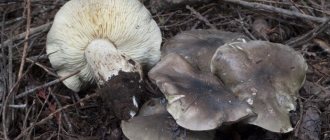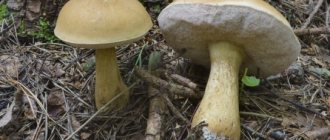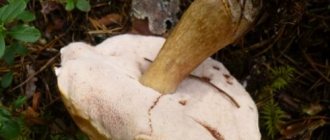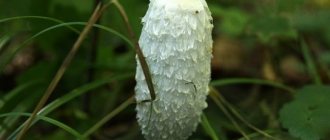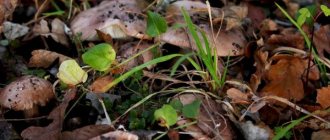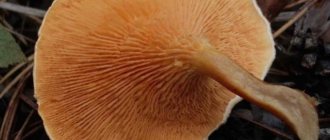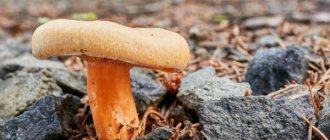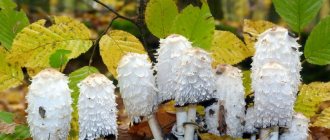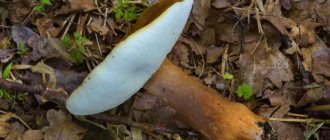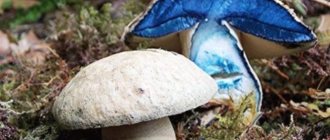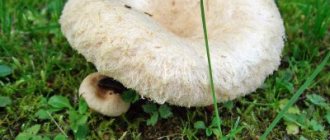Some mushrooms also have to be included in the Red Book; the blue mushroom Gyroporus, or bruise, is one of them. It grows almost throughout the CIS. But it is becoming less and less common due to the deteriorating environmental situation. For this reason, it is considered to be listed in the Red Book not only in Russia. but also throughout the territory of the countries of the former Union.
It is no coincidence that the mushroom received its original popular name - at the slightest touch, its cap and flesh begin to characteristically turn blue. For this reason, some inexperienced mushroom pickers, having cut a mushroom and mistaking it for boletus, believe that they are dealing with almost a poisonous natural phenomenon, and throw it away without regret.
Meanwhile, the mushroom has excellent taste and is considered unconditionally edible.
True, environmentalists advise that if you encounter this rarity in the forest, it is better to leave it where it grows. Still, there are fewer and fewer of these mushrooms left every year, and they grow singly or in small colonies.
Description of the mushroom
Bruise.
hat
The skin of the crop has a yellowish-brown or creamy-white color, which is accompanied by a characteristic dullness. Usually the surface looks dry and feels like high-quality felt.
The usual diameter of the cap is 4-8 cm, but specimens up to 15 cm and even larger are described in the literature.
At the beginning of its growth, the cap of this mushroom has a convex and even spherical shape, but over time it becomes completely flat.
Gyroporus is blue.
Leg
Gyroporus has a stalk of medium thickness up to 3 cm in diameter. The height of the bruise grows from 5 to 10 cm. Like most mushrooms, the stalk at the base is somewhat thicker, and towards the cap its diameter becomes smaller. Its color is the same as the caps, only a little lighter.
The stem of a young mushroom is usually loose, reminiscent of cotton wool, but over time it hardens and characteristic cavities appear in it.
Controversy
The spore powder also differs little from the appearance of the mushroom and has a light yellow color. The tubes reach up to 10 mm in length and at first have a pronounced white color, but as the fungus grows, a yellowish tint appears on them.
Gyroporus birch.
Pulp
The mushroom breaks easily, and a cornflower blue color immediately appears at the break site. And without breaking, the pulp has a very delicate cream or white color. The bruise has practically no characteristic mushroom smell and has a well-recognized nutty taste.
Characteristic features and other names of a bruise
The bruise mushroom is very easy to recognize from just a photo or description, but it is not so easy to find in the forest due to a decrease in its population in recent decades. Other names for the mushroom - blue gyroporus, birch gyroporus - are used much less frequently, since the main distinguishing feature prevails over the others.
Appearance, structure and photo
The cap of a felt-type mushroom changes from convex to flat as it grows; it can have shades of whitish, brown and yellow, but with simple pressure it quickly turns blue at the point of contact. The tubular section has few pores, usually white or straw color, and the spores are yellow. The leg is loose and hollow, without a ring.
The cap of the bruise can reach 15 cm, the leg is cylindrical, up to 8 cm high, and has an extension at the bottom. The pulp is whitish-cream, brittle. The taste and smell are pleasant. When cut or broken, the fruit body turns a characteristic cornflower blue color.
You may be interested in:
What the boletus mushroom looks like and its description (24 photos) The bright dense cap, reminiscent in color of autumn foliage, the thick stem, impressive size and pleasant taste made...Read more...
Location of bruises
Oak forests, coniferous forests, warm sandstones heated by the sun, humidity and a warm climate are the main preferences of these mushrooms. It grows better under birch, pine, chestnut and oak trees, since gyropores form a symbiotic association with the roots of these trees - the exchange of nutrients.
In Russia, these mushrooms are most often found in deciduous and mixed forests of Western Siberia. In Europe and Central Asia, the fungus is more common in the steppe zone.
Edible or inedible
Since the mushroom is rare, many people wonder whether it is edible or not. It is classified into the second or third category of edibility according to different classifications. But according to experienced mushroom pickers, it is edible, tasty and nutritious, although it is suitable for consumption only after heat treatment.
Mushroom in section
Individual intolerance to the fungus is possible due to disorders of the gastrointestinal tract and chronic diseases of the liver and kidneys.
Differences from false mushrooms
Gyropores cannot be confused with dangerous poisonous mushrooms due to their individual characteristic of turning blue.
But due to inexperience, one can easily mistake the chestnut gyroporus for a bruise, which looks very similar to them, but at the first cut of any part of the chestnut twin, the mistake immediately becomes obvious, its fruiting body never turns blue.
Yunkville Boletus
You can also mistake the conditionally edible Yunkville boletus for a bruise; its flesh at the site of the break turns blue, but very soon the blueness turns black.
When and how to collect correctly
Bruises require restoration, without which they can disappear as a species, so they need to be collected very carefully, trying not to damage the mycelium. It is better to cut off only part of the stem, not to take old and damaged mushrooms, leaving them for further propagation.
Good to know!
The most suitable time for collection is late summer or early autumn.
Spreading
Gyroporus cyanescens.
Although the bruise grows everywhere, especially in Russia, it is not common. As a rule, it grows solitarily, preferring sandy warm soils and deciduous forests. Often found under birch, oak or even chestnut trees.
Experts say that it most often grows on the north side of the tree. It usually emerges from the ground when the soil has finally warmed up, and can bear fruit until October.
Self-cultivation
Some mushroom pickers practice growing this rare mushroom on their own in their garden plots.
The main conditions for home growing are warmth, shade and humidity.
Planting technology:
- The powder with mycelium is mixed with dry soil mixture or sand, to which leaves and branches of birch, oak or chestnut are added, i.e. tree species with which the fungus forms mycorrhiza;
- in a selected area under a tree (chestnut, oak), loosen the soil and make a trench to a depth of 10-15 cm;
- the mycelium is evenly scattered into the holes, covering the top with soil mixed with humus;
- plantings are watered by sprinkling at a rate of 10 liters per 1 m²;
- Sprinkle the top again with a thin layer of earth.
Constant moisture is required for cultivation, so in the dry season the planted mycelium needs to be additionally irrigated with 15-20 liters per 1 m².
Experts note that for the fungus to successfully develop, the following crops should not be located next to it on the site: grapes, rye, millet and other crops. This means that you will have to strain to find a suitable place.
Home harvests are usually harvested twice a year - initially in the warm spring and then in the fall.
During the period when the mycelium does not bear fruit, it is recommended to fertilize it by adding humus to the soil.
Edibility
Gyroporus birch.
Although picking these mushrooms is not recommended (and in some regions not allowed) due to their rarity, it is convenient and easy to prepare. It is good both simply boiled and when fried; housewives often prepare it pickled and dried.
It is noteworthy that it is from gyroporus that excellent quality sauces and juliennes are obtained.
Cooking technology
Bruise is an edible mushroom and belongs to category 2 of nutritional value. The taste characteristics are comparable to white.
The bitter taste characteristic of some members of the family is absent.
Due to its limited distribution throughout Russia, the bruise mushroom is known only to a small number of “quiet hunting” lovers. However, it can be an excellent basis for preparing a wide variety of mushroom dishes. In its dried form, the aroma of gyroporus is enhanced several times (the water leaves, only the dry components of the pulp remain) and the mushroom can be used as a seasoning after grinding the powdery mass.
Suitable for drying and making sauces, less often it is fried and pickled.
It is not collected en masse by mushroom pickers in Russia due to its rarity and quickly turning blue flesh, which in itself discourages those interested.
Similar species
It is impossible to confuse a bruise with some other mushroom - no others turn blue at a break or when touched. , chestnut gyroporus is very similar to it .
Chestnut gyroporus is slightly bitter in hot dishes; this must be taken into account when preparing; it is better to use it in dried form.
It is a bit reminiscent of the bruise and the Yunkville boletus , but this boletus is rare, turns black when cut and is generally a conditionally edible mushroom.
1- Gyroporus chestnut. 2- Yunkville boletus or yellow boletus.
Is the bruise mushroom edible or not?
The mushroom is absolutely edible if it does not grow in landfills, areas of former industries, factories or landfills. Boletaceae tend to absorb harmful substances from the soil and accumulate them in themselves. Therefore, when going on a “silent hunt”, you need to make sure that the places where you collect mushrooms are ecologically clean.
Important! Not a single poisonous mushroom known to date turns blue when pressed.
Precautionary measures
Despite the fact that gyroporus is considered not only an edible, but also a tasty and healthy mushroom, it is not recommended to eat it in case of certain diseases and conditions:
Gyroporus is blue.
- it is advisable to exclude it from the diet in case of kidney disease;
- for liver diseases;
- during pregnancy and lactation;
- for gastric ulcers and exacerbation of gastritis.
Soup with bruises
Ingredients: half a kilo of mushrooms, two onions, about five potatoes, a couple of tablespoons of vegetable oil for frying, a handful of prunes without bones, a handful of raisins (like raisins), a large spoon of wheat flour, parsley (a bunch), salt and spices to taste. We use the previously prepared semi-finished product and the second cooking broth.
Note: if you get dried bruises, you need to take 35-50 grams of them and first soak them in water at room temperature for about an hour, and then cook them.
Interesting facts about bruising
- The mushroom has not only excellent taste, but also other beneficial properties.
- The mushroom also contains antioxidants that delay the development of malignant tumors.
- It contains a large amount of vitamins.
- These mushrooms are well suited for many diets, including weight loss.
- In folk medicine it is used as an active natural antibiotic.
- Sodium and magnesium, which are also abundant in these mushrooms, support the circulatory system well.
The mushroom was first described in detail by the French botanist Jean Baptiste Bulliard, but it gained particular popularity in Russia.
Some of the disadvantages of this culture include the fact that gyroporuses cannot be stored for a long time, even in the refrigerator. After 2-3 days they deteriorate, so it is advisable to prepare them immediately after collection.
Blue gyroporuses are truly a unique natural phenomenon and very peculiar. Therefore, if you find them in the forest, do not rush to pick the mushroom, especially if it grows alone. There are other mushrooms that you can pick nearby - boletus, boletus and many others. And it would be good to preserve this obvious rarity.
How to cook mushroom bruise
To prepare the bruise mushroom, you need to decide on the purpose: whether the crop will be eaten immediately or stored for the winter.
For reserves, it is recommended to dry the mushrooms. To do this, the bruises are cleared of forest debris and strung on threads or laid out in a special dryer. Large specimens need to be cut, small mushrooms can be dried whole.
If you plan to cook a dish or marinate a product, the mushroom mass should be boiled.
To do this you need:
- Pour water into the pan at a ratio of 1:3.
- Place the mushrooms in boiling water and cook over medium heat for 10 minutes.
- Drain the water and fill the pan with fresh water.
- Bring to a boil again, but with the mushrooms.
- After boiling, reduce heat and cook the product for 15 minutes.
You can make any dish with boiled mushroom mass: soup, stew or gravy, as well as pickled preparations. Each housewife has her own recipes for preparing mushrooms at hand, for example, creamy gravy from bruises with chicken breast.
For 500 g of chicken breast fillet you need to take:
- 200 - 300 g mushrooms;
- 2 medium onions;
- 100 ml of cream 10% fat (if there is no cream, you can replace it with milk, about 0.5 l).
Preparation procedure:
- Mushrooms and chicken fillet, cut as desired, are fried in oil over high heat for 1 - 2 minutes.
- Then reduce the heat and add chopped onions.
- Simmer everything covered for 5 minutes.
Add salt and your favorite spices to taste, pour in cream or milk and simmer under the lid until the chicken is cooked.
You can add water to the cream: it all depends on your preference for the consistency of the gravy. The dish is served with pasta, rice, buckwheat or boiled potatoes.
Poisonous and inedible types of mushroom
There are much fewer inedible mushrooms that turn blue when cut than edible ones. That is why, in order not to make mistakes, it is important to know them.
Kele's Oak (Boletus queletii)
A mushroom from the genus Borovik, inedible (although some sources classify it as conditionally edible). Externally similar to the satanic mushroom. The cap is brown, convex, 5-15 cm in diameter. The stem is thickened downward, smooth, yellow.
When pressed, the stem and tubular layer of the Kele oak instantly turn blue.
This mushroom is relatively rare; it can be found in the deciduous forests of the Caucasus, less often in the Far East. The Kele dubovik prefers acidic and infertile soils, moss and short grass. Fruiting time: from May to October.
Dubovik Kele
Satanic mushroom (Boletus satanas)
It also belongs to the boletus species and is similar in appearance to other representatives of this genus. In its raw form, the mushroom is poisonous, and even after heat treatment it can cause a serious disorder with characteristic symptoms of poisoning.
The satanic mushroom has a massive convex cap with an uneven surface, grayish in color. Sometimes there are huge specimens (up to 30 cm).
The leg is thick, ovoid, red in color. When cut, the color of the pulp turns blue within a few minutes, then red.
Satanic mushroom
Gall mushroom or mustard
A tubular mushroom, inedible due to its bitterness, which gives it its name. When cooked, the unpleasant taste of bittersweet only intensifies. There is an opinion that it greatly harms the liver, but symptoms of poisoning do not appear immediately.
Another name for this species is false white, because. due to their external similarity, they can be confused. The bitterling cap is spongy, light brown, smooth. The leg is massive and fibrous.
The gall mushroom grows on all continents. Prefers coniferous forests and acidic fertile soils. It is found everywhere in Russia. It actively bears fruit from the end of June to October; with early frosts, it completes the growing season in September.
Bile mushroom
Use
Mushrooms are edible, there is no bitterness in them, the taste and aroma are pleasant. During heat treatment, mushrooms do not become tough.
Due to their beneficial properties, bruises are used in cooking and medicine:
- Blue gyroporus contains the natural antibiotic boletol.
- The presence of antioxidants allows the fruiting bodies to be used as a prophylactic agent in the treatment of tumors.
- Microelements such as potassium, magnesium, sodium contained in bruises are easily absorbed by the body. That is why it is recommended to use blue gyroporus to prevent diseases of the cardiovascular system and increase immunity.
Important! During pregnancy and while breastfeeding, mushrooms should not be consumed. This also applies to children.
Fruits collected in the forest can be left in the refrigerator for three days, and boiled ones are suitable for 2-3 days, but only in decoction. Blue gyroporuses can be dried, stewed, fried, and cooked with them in soups, sauces, and stews. Connoisseurs of mushroom dishes, in addition to various vegetables, add raisins and prunes. Bruises fried with nuts look delicious.
Preparing bruises, recipes for the winter
Despite the amazing taste and aroma, in order to eliminate problems with digestive disorders, the fruits first go through heat treatment, and only then are used as an ingredient for cooking. Whole mushrooms are washed under running water and then boiled twice, each time in clean water. Afterwards, the bruises are removed using a slotted spoon into a plate, washed and dried on paper towels. And only after the work has been done, they begin to repeat the recipe they liked for the first or second course, pickling, preserving or salting for the winter.
Classic marinating recipe
To preserve the nutty notes, it is worth prolonging the pleasure of consumption, preferring pickling for the winter to preparing a delicious dinner.
Products:
- 1.5 kg of mushroom pulp;
- 0.5 liters of water;
- 2 table. l. table vinegar 9%;
- 2 table. l. salt;
- 1 tsp. l. Sahara;
- a few leaves of horseradish, cherry and oak to add crunch;
- herbs, seasonings - to taste;
- one clove of garlic per 0.5 liter.
1) After cleaning and initial boiling, the mushrooms are washed and placed in a clean pan. On top - pour in water, cover with a lid and place on the stove, setting the minimum temperature on the burner.
2) As soon as the water boils, add salt and sugar, herbs and spices, mix well.
3) After 3-5 minutes, add vinegar, mix and leave for a few minutes.
4) Leaves and garlic are placed in pre-sterilized 0.5-ounce jars. Place mushrooms on top using a slotted spoon. Preservation is completed by pouring the marinade, screwing on the lids and covering until completely cooled.
Alternative dishes, list of best options:
- potatoes with sour cream and mushrooms;
- julienne;
- rich pastries, including: pies and fried pies, buns based on yeast dough with mushroom filling;
- Chicken and Bruise Roast;
- light or rich noodle soup;
- vareniki;
- vegetable stew with the addition of meat and mushrooms.
Important!
To avoid poisoning or intoxication of the body, it is recommended to avoid collecting mushrooms in contaminated areas. Mushrooms are like a sponge, absorbing toxins and carcinogens in addition to their usefulness. Mycologists advise avoiding forest areas bordering industrial zones, highways, cemeteries and landfills, where the soil and air are far from ideal.
Growing at home and in the country
Growing wild mushrooms in the country is not very difficult. First of all, you need to choose a place under a tree, like in a forest. In the case of gyroporus, oak or any other garden tree is perfect.
One of the main conditions for growing in the country is that the place should be shady and humid. If there are no trees at all, then you can find shade near the gazebo, under the roof, the main thing is that grapes, rye, wheat, millet and other crops are not planted nearby.
It’s not difficult to purchase mycelium, but you can make it yourself. To do this, it is necessary to collect spores from the bruise, and this can be done from overripe fruits. The seeds need to be mixed in a container or container with water (it is better to take it from a river or collect it after rain, so that the mushroom feels more comfortable at home). Add a few tablespoons of sugar. All this is mixed until a homogeneous mass is formed.
Important: do not forget that growing wild mushrooms is quite difficult for a beginner. This will require knowledge, work and patience.
How to collect
Gyroporus blue begins to bear fruit from July and until the end of September - beginning of October, these mushrooms can be collected. At the same time, the most massive growth occurs in August.
This species is heat-loving: fruiting bodies appear when the soil is sufficiently and stably heated. Prefers moist, well-lit places. Moreover, it most often grows on the north side of the tree.
Information! Especially blue gyroporus likes to settle in places with an abundance of moss, where it can provide itself with a sufficient amount of moisture.
As with most mushrooms, when collecting, preference should be given to young specimens, since with age, voids appear in the stem, and later it becomes completely hollow. In addition, older mushrooms are often attacked by insects and pests.
Many, especially beginners, mushroom pickers are interested in how to trim blue gyroporus. Since this mushroom is considered quite rare and is under state protection, when collecting it is necessary to take special care of the safety of the mycelium, so that it will produce a harvest next year and not die.
Important! When collecting the Gyroporus blue mushroom, it is strictly prohibited to pull out and pull out the fruiting bodies from the ground. This leads to damage to the mycelium and its death.
The most correct and non-traumatic way to harvest blue gyroporus is to cut it close to the ground with a sharp knife. At the same time, the fruiting bodies remain clean, which is very important during transportation and, most importantly, in preparation for the main culinary processing.
Mushrooms can also be twisted, for which the fruiting body is first slightly shaken from side to side, and then also carefully twisted. In this case, damage to the mycelium is minimal.
Important! It should be remembered that mushrooms tend to accumulate all kinds of toxins and heavy metals from the soil. Therefore, to collect blue gyroporus, you need to choose environmentally friendly places, away from industrial enterprises, roads, etc.
False doubles
Inedible boletus
Gyroporus blue bears little resemblance to the inedible boletus, but it is larger and has yellow pores. At first it may taste sweet, but then an unpleasant bitterness is felt.
Bile mushroom
Inexperienced lovers of “silent hunting” often confuse gyroporus with porcini mushroom. At first glance, it is easy to mistake it for a gall mushroom (inedible white). It is not poisonous, but with any processing the bitterness does not disappear, so it is not suitable for food.
The main difference between Gyroporus and all other mushrooms is that they turn blue when pressed. No other doppelgänger acquires this coloration.
How to store
Gyroporus blue is a tasty, aromatic mushroom and, according to fans of mushroom cooking, in ready-made dishes it is not much inferior to the king of mushrooms - the porcini mushroom. With proper pre-cooking processing, the blue color of the pulp disappears, and the fruiting bodies acquire an appetizing light shade.
Like its more famous brother, blue gyroporus is universal and perfectly reveals its taste in any type of preparation. Showed itself well in canning.
The simplest and least troublesome way to preserve blue gyroporus for use out of season is by drying. In this case, there is no need to wash or boil the mushrooms first; it is enough to clean them properly. Drying is carried out in the open air. You can also use an oven, microwave or Russian oven, or a special electric dryer for these purposes.
Important! Mushrooms intended for drying and freezing should not be washed.
For better air circulation, prepared dried mushrooms are stored in cloth bags away from strong-smelling foods and substances. At room temperature, the shelf life of blue gyroporus is up to six months. In dry, dark rooms with low air temperatures, the period can be extended to 9-12 months.
Another fairly quick way to preserve the beneficial properties of blue gyroporus for the winter is freezing. For these purposes, raw, pre-prepared mushrooms are used.
The preliminary preparation of blue gyroporuses intended for freezing and drying is similar and is carried out according to the general scheme. An important distinguishing point is that mushrooms cannot be washed. Therefore, washing is replaced by wiping the surface of each specimen with a damp cloth. Then the fruiting bodies are placed in containers or zip bags and frozen.
Important! Since repeated freezing of mushrooms leads to a deterioration in their quality, prepared mushrooms should be frozen, divided into portions, so that one is enough to prepare one dish.
And, of course, there are few people who can resist the unique taste and aroma of salted or pickled mushrooms. It is believed that when pickled, blue gyroporuses may well compete with porcini mushrooms.
In cooking, such preparations have found the widest application and are of great help in preparing a wide variety of dishes. Mushrooms are a good savory addition to both meat and vegetable dishes. They are used independently, as well as for decorating ready-made dishes.
Important! For salting blue gyroporus, only the hot method is suitable.
Geography of growth and time of collection
Distributed everywhere in northern regions with temperate climatic conditions, however, it is not common in Russia.
It prefers to settle in places where deciduous trees grow, especially near birch trees, with which it enters into a symbiotic association (forms mycorrhiza).
Irina Selyutina (Biologist):
Gyroporus is occasionally found in Europe and North America. In the post-Soviet space, it can be found in the European part of the former USSR, in the Caucasus and the Far East.
It can also be found in mixed forests where there are chestnuts and oaks. It grows more often on sandy soils.
The bruise in nature has natural enemies - wild boars that tear apart the mycelium.
Fruiting begins in the warm season, when the soil warms up sufficiently. The peak appearance of fruiting bodies occurs between July and September. Fruits singly.
Edibility, beneficial properties and contraindications for use
The violet row has its own characteristics in cooking
It is very important to correctly approach the issues of processing fruits before eating, otherwise you can harm your health
Cooking features
Immediately upon arriving home, the blueberries are cleaned of plant debris and spoiled or wormy fruits are removed. Then they are cleaned and soaked in salted water. The fluid needs to be changed periodically 3-4 times.
After this, the mushrooms are boiled in salted water for 30 minutes and washed again under running water. After this, the rows are fried, salted or pickled.
Application in medicine
Ryadovka finds its wide application in medicine. An oncological extract is obtained from its mycelium, thanks to which, as part of anti-cancer therapy, it is possible to restrain the growth of breast cancer.
Good to know!
In addition, the mushroom has an antibacterial effect - it affects streptococcal and staphylococcal infections, and also helps to cure E. coli. The presence of B vitamins allows it to be actively used in the prevention of influenza and strengthening human immunity.
Blueberry is a mushroom with a specific color, a tasty product in any kitchen if properly prepared and processed. In order not to make a mistake when collecting rows and not to confuse them with other inedible similar species, you need to know its distinctive features.
